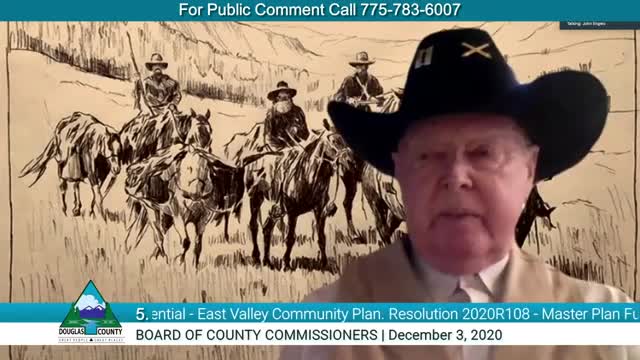Commissioners clash over Johnson Lane zoning change amid water supply concerns
December 26, 2024 | Douglas County, Nevada
This article was created by AI summarizing key points discussed. AI makes mistakes, so for full details and context, please refer to the video of the full meeting. Please report any errors so we can fix them. Report an error »

In a recent meeting of the Douglas County Board of County Commissioners, a heated discussion unfolded regarding a proposed zoning change that could significantly impact the Johnson Lane area. The atmosphere was charged as commissioners debated the merits and implications of transitioning from Forest and Range (FR) zoning to Single Family Residential (SFR) zoning, a move that some believe could lead to increased development in a region already grappling with infrastructure challenges.
Commissioner Ingalls voiced strong opposition to the zoning change, emphasizing the need for municipal water connections to support any new residential development. He pointed out that existing nitrate levels in the area are under scrutiny, with the potential for residents to be required to switch to county water and sewer systems if conditions worsen. This concern highlights the delicate balance between growth and environmental sustainability in the region.
The conversation shifted as other commissioners weighed in, with some arguing that the county currently has an adequate supply of lots available for development. Commissioner Rice noted that the average annual construction of 173 homes over the past five years does not indicate uncontrolled growth. However, the looming question of infrastructure—particularly the capacity of local roads to handle increased traffic—remained a focal point of concern.
As the dialogue progressed, the notion of demand for housing emerged. Some commissioners argued that the influx of new residents, particularly from California, could justify the need for more housing options. Yet, others countered that the existing inventory of lots is sufficient, and further development could exacerbate traffic congestion and strain local resources.
The discussion also touched on the legal complexities surrounding deed restrictions on the land in question. It was clarified that lifting such restrictions would be a challenging process, potentially requiring court intervention. This aspect added another layer of complexity to the decision-making process, as commissioners considered the long-term implications of their choices.
Ultimately, the meeting underscored the ongoing tension between development and preservation in Douglas County. As the commissioners grapple with these issues, the future of the Johnson Lane area hangs in the balance, reflecting broader themes of growth management, environmental stewardship, and community planning. The outcome of this zoning change could set a precedent for how the county navigates similar challenges in the years to come.
Commissioner Ingalls voiced strong opposition to the zoning change, emphasizing the need for municipal water connections to support any new residential development. He pointed out that existing nitrate levels in the area are under scrutiny, with the potential for residents to be required to switch to county water and sewer systems if conditions worsen. This concern highlights the delicate balance between growth and environmental sustainability in the region.
The conversation shifted as other commissioners weighed in, with some arguing that the county currently has an adequate supply of lots available for development. Commissioner Rice noted that the average annual construction of 173 homes over the past five years does not indicate uncontrolled growth. However, the looming question of infrastructure—particularly the capacity of local roads to handle increased traffic—remained a focal point of concern.
As the dialogue progressed, the notion of demand for housing emerged. Some commissioners argued that the influx of new residents, particularly from California, could justify the need for more housing options. Yet, others countered that the existing inventory of lots is sufficient, and further development could exacerbate traffic congestion and strain local resources.
The discussion also touched on the legal complexities surrounding deed restrictions on the land in question. It was clarified that lifting such restrictions would be a challenging process, potentially requiring court intervention. This aspect added another layer of complexity to the decision-making process, as commissioners considered the long-term implications of their choices.
Ultimately, the meeting underscored the ongoing tension between development and preservation in Douglas County. As the commissioners grapple with these issues, the future of the Johnson Lane area hangs in the balance, reflecting broader themes of growth management, environmental stewardship, and community planning. The outcome of this zoning change could set a precedent for how the county navigates similar challenges in the years to come.
View full meeting
This article is based on a recent meeting—watch the full video and explore the complete transcript for deeper insights into the discussion.
View full meeting